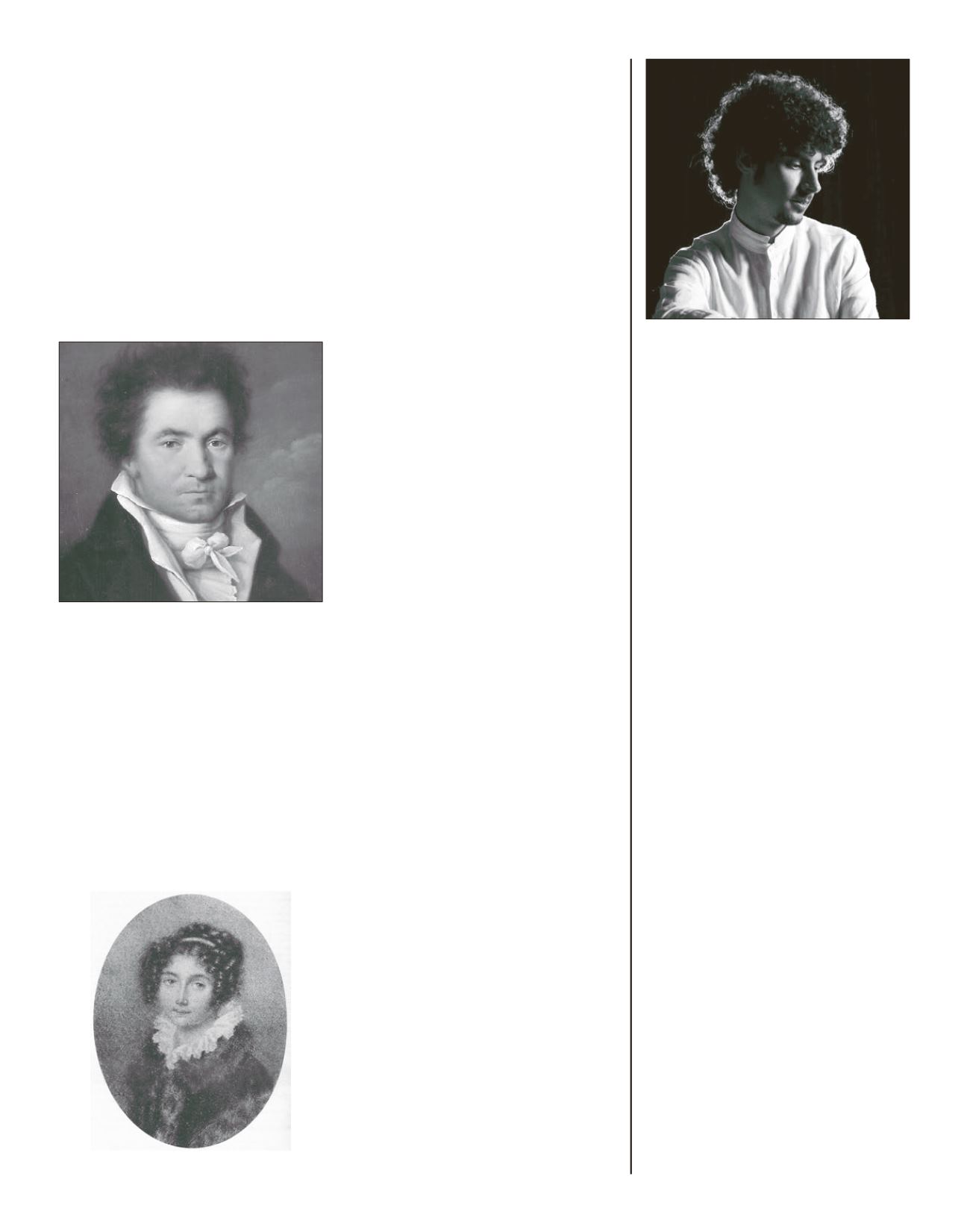
known today as the “Heiligenstadt Testament”—
an unmailed letter to his brothers written during
his stay in the village of Heiligenstadt in
—
and to have eeting thoughts of ending his own
life. His spirit was liberated by this secret disclo-
sure, and Beethoven’s general outlook began to
improve as he took refuge in his work: “It was
only my art that held me back. Ah, it seemed
to me impossible to leave the world until I had
brought forth all that I felt was within me.” e
months following his return from Heiligenstadt
brought a steady ow of compositions, includ-
ing the Symphony No. (“Eroica”), Piano So-
nata No. (“Waldstein”), Violin Sonata No.
(“Kreutzer”), and the oratorio
Christus am Oel-
berge
(
Christ on the Mount of Olives
).
is vigorous creative activity slowed con-
siderably at the end of
and beginning of
. Work on
Leonore
(later renamed
Fidelio
),
Beethoven’s rst operatic composition for the
eater an der Wien, demanded total concen-
tration. His attention was further divided by
growing a ection for the recently widowed Jose-
phine von Brunsvik. Several writers have com-
mented on the theme of faithful love common
to both the opera and Beethoven’s relationship
with Josephine.
ese weighty matters allowed
little time for other compositions.
FEDERICO COLLI,
piano
Italian pianist Federico Colli announced his
arrival on the world stage with winning perfor-
mances at the Salzburg Mozart Competition in
and the Leeds International Piano Compe-
tition in
. During his studies at the Milan
Conservatory, Imola International Piano Acade-
my, and Salzburg Mozarteum, he was mentored
by such luminaries as Sergio Marengoni, Kon-
stantin Bogino, Boris Petrushansky, and Pavel
Gililov. e same year that he won the Salzburg
competition, Colli was awarded a Grosso d’Ar-
gento by the mayor of his hometown of Brescia.
He was subsequently named among the top
pianists under by
International Piano
mag-
azine in
, the same year that he made his
debut on the International Piano Series at Lon-
don’s Southbank Centre and released his debut
solo CD, a collection of works by Beethoven,
Scriabin, and Mussorgsky on the Champs Hill
label. Colli has since begun to record exclusive-
ly with Chandos; his rst disc on the label was
released in May this year, featuring sonatas by
Domenico Scarlatti, and a new album of Bach
works, including Busoni arrangements, has
been planned. On the concert stage, his recent
highlights have included debuts at London’s
Royal Albert Hall and Cadogan Hall with the
Royal Philharmonic Orchestra; further concerto
performances with the Janáček Philharmonic,
Orchestra Sinfonica di Milano Giuseppe Verdi,
and Lodz Philharmonic; and recitals at the Lu-
cerne Piano Festival, Turner Sims Southampton,
Lakeside Arts Centre Nottingham, and Fazioli
Concert Hall. Colli has also bowed with the Ma-
riinsky Orchestra, Saint Petersburg Philharmon-
ic, Accademia Nazionale di Santa Cecilia, RAI
National Symphony Orchestra, Royal Scottish
National Orchestra, Royal Liverpool Philhar-
monic, Hallé Orchestra, Philharmonia Orches-
tra, Vienna Chamber Orchestra, and Camerata
Salzburg, as well as at Vienna’s Musikverein and
Konzerthaus, Berlin’s Konzerthaus, Munich’s
Herkulessaal, Bonn’s Beethovenhalle, Amster-
dam’s Concertgebouw, London’s Barbican Cen-
tre, Queen Elizabeth Hall, Paris’s Salle Cortot,
and Tokyo’s Nikkei Hall, among many other
venues. Federico Colli is making his US debut
tonight at Ravinia.
e Piano Sonata No. in F minor was one of
the few pieces created during the period when
Beethoven’s relationship with Josephine was at
its strongest—the years
and
.
e Vi-
enna Bureau des Arts et d’Industrie published
this sonata in
with a dedication to Count
Franz von Brunsvik, Josephine’s brother. Its
emotional turbulence, dynamic intensity, and
expressive harmonies may mirror Beethoven’s
inner passions, but the composer did not him-
self attach the nickname “Appassionata” to this
work.
e title rst appeared in the
four-
hand version by the Hamburg publisher Cranz.
For many years, this sonata was among the com-
poser’s personal favorites.
e “Appassionata” opens with a tempestuous
movement whose expression transcends the
boundaries of sonata form. Its rst theme pres-
ents a quiet, haunting F-minor arpeggio in /
time. underous chords shatter the initial calm
and are followed by a tranquil and expressive
second theme.
e
Andante con moto
o ers a
set of variations based on a simple and stately
theme. All three variations that follow retain the
basic structure of the theme, but with increas-
ingly complex embellishment.
is movement
proceeds without interruption into the nale
by way of
fortissimo
chords. A quiet rst theme
enters a er several measures of introduction,
rising and falling in gentle waves of sound. e
second theme combines rapid imitation with ac-
cented chords. A
presto
coda propels this sonata
to an exhilarating conclusion.
–Program notes ©
Todd E. Sullivan
Ludwig van Beethoven by Joseph Willibrord Mähler
(1815)
Josephine von Brunsvik
6(PT(0%(R ɰ 6(PT(0%(R
_ R$9,1,$ 0$*$=,1(
101








